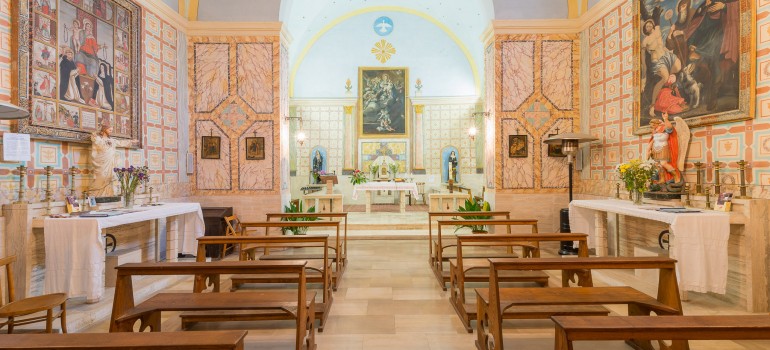
The Church of San Michele Arcangelo is in the village of Casto in Montegallo. Surely already at the beginning of the century. XV there was the parish church of S. Angelo (St. Michael), then rebuilt and reconfigured to finally assume its current appearance. The dedication to the Archangel warrior already patron of the Lombards, is an element of great interest, linked to a rooted fabric of popular beliefs, where the vivid figure of the soldier of God acquired a special force is not without arcane resonances. The church gives attention with his left side open two portals the largest of which features an unusual elegance of forms. Featuring a light sloping moldings, has a registered entablature crowned by a cornice and topped with a bezel. The spouse is coping with the frame groove that surrounds and enhances the bezel itself. A globe concludes at the height set. Lintel reads the date 1556. The inscription of the entablature, however, worn by time, comes with a cursive capital not easy to decipher. Judging by the opening words: T (m) P (or) AND (OMI) NI …… was putting the information relating to the commission of the work. The exhibition of the bezel finally welcomes a fresco depicting the Pietà with the Christ lying in the lap of Mary. It should be remembered that the church kept a sculpture in painted wood of local art dating from the end of the century. XV with the same subject represented in different ways and forms in all similar. The work is now kept in the Diocesan Museum of Ascoli Piceno. The pathos and the linearity of compositional clear emphasis devotional wooden borrowed from the work itself exemplified the tradition of the nearby Abruzzo, so striking contrast with the Renaissance composure of the portal. A similar contrast is put in place by the epigraph, which exhibits a layout and font rendering somewhat lacking rigor in place capitalization lapidary of classical evidence that characterize portals Ascoli era. Membership in the schema of the portal to a type spread their axes in civil sixteenth Ascoli, on the other hand suggests that the portal is due to Castro Lombard workers then very active in the city, and that is just in the creation in stingevano series of doors, frames and windows wise calibration formal. The inscription and the fresco instead reveal the imprint of a local flavor, free from conventions and stylistic rules. On the right side, at the corner of the facade, it is detected sundial fragmented re-use. On the right wall of the classroom it is observed carved and painted wooden crucifix dating back to centuries. XVI. It ‘s remarkable for the articulation of the pose and accurate summary of the cost for the treatment, made with rigid parallel lines. Arouses effect thanks to the realism of the expression (the head inclined, eyes shut, mouth ajar) that joins the linearity of vivid facial features. On the left, behind the devotional statue of St. Michael stands a large altarpiece with Our Lady of the Rosary; St. Francis and St. Clare surrounded by the representation of 15 episodes from the life of Jesus. In the center pane you look at the inscription: VOS MARIA P (e) R (hi) BETE / DE ROSAS STRINGS / prudish / ILLA EX / Empirio POMA / BEATA dabit / Anno Domini 1613 (you offer roses to Mary with a pure heart: She will bear fruit Empyrean blessed year of the Lord 1613). Framed composition a sumptuous frame with inserts of wood carved and gilded. The treatment of the figures, immediate and primary, have the vividness and the spontaneity of votive, and aims at the same time in a context of evidence and monumentality. Particularly tasty pane of the Presentation in the Temple, with the priest in baskets cardinals and altar decorated on the front by a more croce.All’altare stands an imposing altarpiece depicting the Madonna and Child in Glory between S: Michael, S . Peter and Blessed by Marco Smelter: Of some interest iconographic for insertion of the Archangel and Blessed local, the painting offers a remarkable scan plans and building a fairly persuasive. Despite certain stiffness, despite the size of the figure of Blessed Marco, not well correlated to the two floating, delicious angels represented in the foreground, despite the lack of attention to the relationship between light and blocks of figures, the blade proves safe expressive qualities not lacking complacency, presenting itself with pleasant effects of boldness. It will be of great interest a thorough study of this composition, which will certainly recognize the relationships with painting Ascoli between ‘600 and’ 700, where the compositional devices of the Roman school bluntly echoed in the blade in question were re – interpreted by ‘ by Ludovico Trasi (1634-1695) and Tommaso Nardini (1658-1718). Remarkably mediocre on the right wall of the classroom, the seventeenth-century altarpiece, accompanying the altar dedicated to St. Sebastian.
Altri monumenti a Montegallo
 Lascia un commento
Lascia un commento